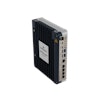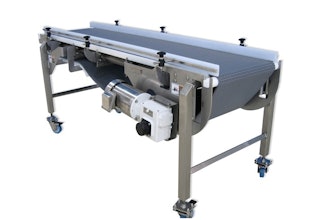Weight Loss Device Bolts on to Your Molars
About four months ago, researchers at the University of Otago in New Zealand and out of the U.K. developed a new weight loss device. While effective, it looks a bit medieval.
The DentalSlim Diet Control is an intra-oral device installed by your dentist on your upper and lower back teeth. Think of it as a chastity belt for your face, just one that attacks the global obesity epidemic.
Now, the promo shot looks peculiar but manageable as it's placed on a model. However, the photos of the device in a human mouth tell a much more unsettling story. If pictures have a thousand words to say, these are all horrifying, something that would have the John Doe character from Seven salivating.
The device consists of closed-field magnets and orthodontic bands, and it's bolted into your mouth. After installation, the wearer can only open their mouth about 2 mm. It restricts them to a liquid diet, but they can still breathe and speak with relative ease.
The researchers held a clinical study to see if DentalSlim would work and whether or not it would drive the person crazy. The device was cemented to the first molar in seven obese but otherwise healthy subjects.
In the two-week trial, the subjects lost about 14 pounds which worked out to about 5.1% of their body weight.
While they had trouble pronouncing some words and felt tense and embarrassed at times, the device didn't seem to affect their taste or trigger any discomfort when drinking. They lost weight and were motivated to lose more, but the participants sometimes felt that life, in general, was "less satisfying." Researchers contend that the device could help save or improve millions of lives.
Next, the team will work to make the device smaller, more functional and comfortable -- as well as a bit more aesthetically pleasing. And never before has the Bond villain Jaws seemed so close to reality.
Robot Rats Autonomously Control Living Counterparts
Researchers from the Beijing Institute of Technology have created a biomimetic robotic rat that they believe to be a possible bridge to the natural interaction between robots and animals.
While lab rats have proven to be ideal models for testing new drugs and other research, they're hard to control. Bio-inspired robots could be a suitable solution. The team believes that robot rodents can influence or even control living rat behavior autonomously. Until now, many obstacles have stood in the way of robot rat advancement, like behavior detection, fast object tracking and a lack of an automatic interaction framework.
The previous iteration only had two legs in front and wheels in the back, kind of looked like a rat rickshaw. Still, it was outfitted with a miniature vision perception system and had nine active degrees of freedom that gave it a more natural rat-like motion. The movement helped the bots autonomously interact with actual rats.
The team then developed a quadruped version that more closely mimics the shape and movements of rats. The new rat robot is faster, stronger and has a tighter turning radius. It is also more capable of crossing irregular passages, climbing slopes and recovering from falls.
The researchers developed an automatic robot-rat interaction framework that allows the robot rat to perform real-time localization, tracking and movement analysis of lab rats. In tests, the robot was able to track a fast-moving rat for 10 minutes. It is likely the first time that a rat-sized robot tracked rats using a built-in miniature stereo vision system.
They live among them, they control them, and they have no idea. They Live. Body snatching aside, we'll stop this before it's undetectable autonomous cyborgs, right. Right?
Weaponizing the Fog of War
Typically, the fog of war refers to uncertainty, but now DARPA hopes to make it a tactical advantage.
DARPA recently announced the Coded Visibility program, an effort to weaponize fog, or smoke, obscurants. The military uses obscurants to protect soldiers and make it harder to see them, be it with enemy eyes or sensors.
According to DARPA, despite their popularity, obscurants have their limitations. For example, popping smoke also makes it difficult for soldiers to see. Once deployed, the smoke's performance is fixed and can't be tuned in real-time, and some pose severe health risks to the soldiers. To counter infrared systems, some obscurants are made of metallic flakes that are dangerous to breathe, and soldiers need to wear respirators.
With Coded Visibility, DARPA hopes to develop next-gen designs that provide a tactical advantage, not just obscuring visibility for enemies but enhancing visibility for friendly fighters.
They call it passive asymmetry, and you can think of it as a type of one-way mirror with gas.
The program is looking for tunable obscurants (or actively modulating novel particulates) that could be controlled after they were deployed so U.S. soldiers can see the enemy without the enemy ever seeing a soldier.
By the end of the program, DARPA hopes to take these advances at the particulate level and use them in one-way smoke plume demonstrations. Feels like it might have a play in the consumer market, not just with novelty smoke bombs but potentially the cigarette and vape markets.






















